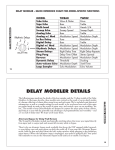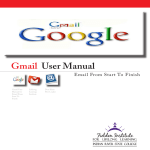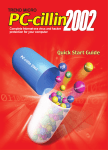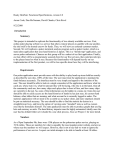Download Wiley BlackBerry Pearl For Dummies
Transcript
Chapter 1 In This Chapter A berry, berry long time ago TE RI AL Your BlackBerry Is Not an Edible Fruit Checking out your BlackBerry behind the scenes MA Seeing what your BlackBerry can do D Managing memory B PY RI GH TE ecause you’re reading this book, you probably have a BlackBerry Pearl (um, and we’re pretty sure that you’re not eating it). We’re just curious, though — what convinced you to buy this particular handheld mobile device? Was it the always-connected e-mail? Or the 1.3 mega-pixel camera? Or the microSD slot capability? Or was it the really good sales pitch? We know; the list could go on and on — and we might never hit on the exact reason why you got yours. For whatever reason you bought your BlackBerry Pearl, congratulations; you made an intelligent choice. CO The same smarts that made you buy your Pearl are clearly at it again. This time, your native intelligence led you to pick up this book, perhaps because your intuition is telling you that there’s more to this whole BlackBerry than meets the eye. Your hunch is right. Your BlackBerry can help you do more things than you could ever think of. For example, your BlackBerry is a whiz at making phone calls, but it’s also a computer that you can use to check your e-mail as well as surf the Web. We’re talking World Wide Web here, so the sky’s the limit. Help is always at your fingertips rather than sitting on some desk at home or at the office. Need to check out the reviews of that restaurant on the corner? Need to see (right now) what’s showing in your local movie theaters, or what the weather will be like later tonight, or the best place to shop? Need to get directions to that cozy bed and breakfast, or news headlines, or stock quotes? Want to do some online 8 Part I: Meet and Greet Your BlackBerry Pearl chatting or view some pictures online and download them? You can do all these things (and more) by using your BlackBerry. BlackBerry Pearl is also a full-fledged personal digital assistant (PDA). Out of the box, it provides you with the organizational tools you need to set up to-do lists, manage your appointments, take care of your address books, and more. Being armed with a device that’s a sleek phone, a camera, a portal flash drive, an Internet connection, and a PDA all built into one makes you a power person. With your BlackBerry (along with this resourceful book), you really can improve your productivity, better organize yourself, and increase your cool factor. Watch out, world! Person bearing a BlackBerry Pearl coming through! If you stick with us throughout this book, you’ll find out all you need to get the most out of your device or maybe even stave off (or save) a troubled relationship. (Well, the last one is a bit of an exaggeration, but we got your attention, right?) Knowing Your BlackBerry History Your BlackBerry Pearl is truly a wondrous device, boasting many features beyond your ordinary mobile phone. And its “sudden” popularity didn’t happen overnight. Like any other good product out there, BlackBerry Pearl has come a long way from its (relatively humble) beginnings. In the days when the Palm Pilot ruled the PDA world, Research in Motion (RIM, the maker of the BlackBerry) was busy in its lab, ignoring the then-popular graffiti input method to design its own device with the QWERTY keyboard — the kind of keyboard people were already used to from working on their PCs. RIM didn’t stop there, however. It also added an always-connected e-mail capability, making this device a must-have among government officials as well as professionals in the finance and health industries. To meet the needs of government officials and industry professionals, RIM made reliability, security, and durability the priorities when manufacturing its devices. Today, the BlackBerry Pearl comes from the same line of RIM family products, inheriting all the good genes while boosting usability and especially multimedia capabilities. As a result, BlackBerry Pearl has become the hippest smart-phone — and no longer just for big corporate hot-shots and government officials. Chapter 1: Your BlackBerry Is Not an Edible Fruit 9 How It Works: The Schematic Approach For those of you who always ask, “How do they do that?” you don’t have to go far; this little section is just for you. The role of the network service provider Along with wondering how your BlackBerry actually works, you might also be wondering why you didn’t get your BlackBerry from RIM instead of a network service provider such as Cingular or TMobile? Why did you need to go through a middle-person? After all, RIM makes BlackBerry. Those are excellent questions — and here’s a quick-and-dirty answer. RIM needs a delivery system — a communication medium, as it were — for its technology to work. Not in a position to come up with such a delivery system all by its lonesome, RIM partnered (and built alliances across the globe) with what developed into its network service providers — the usual suspects (meaning the big cellphone companies). These middle-providers support the wireless network for your BlackBerry so that you have signals to connect to the BlackBerry Internet Service — which means you can get all those wonderful e-mails (and waste so much valuable time surfing the Internet). See Figure 1-1 for a schematic overview of this process. Network service providers don’t build alliances for nothing, right? In return, RIM gave them the right to brand their names on the BlackBerry they offer for sale. For example, a T-Mobile Pearl may look different from a similar model you would get from Vodafone. Which leads to another question: Do BlackBerry functionalities differ from phone model to phone model? Quick answer: In the core BlackBerry applications (such as Tasks and Address Book), you find no major differences. However, some BlackBerry features, such as Instant Messaging, might or might not be supported by the network service provider. (See Chapter 8 for more details on Instant Messaging.) 10 Part I: Meet and Greet Your BlackBerry Pearl Web servers BlackBerry Internet Service (BIS) Wireless network E-mail servers (personal and Enterprise) Figure 1-1: Your e-mail travels to your BlackBerry via service providers. Connecting to your personal computer Nowadays, a personal computer is a household necessity. We spend so much time on them, and so much information is stored in them. It should come as no surprise that BlackBerry works hand-in-hand with your PC. The USB cable that comes with your BlackBerry does more than just charge your device. All the chapters in Part IV are dedicated to guiding you in making use of this important connection with the help of the BlackBerry Desktop Manager and all the utilities that come with it. You find discussions in Chapter 13 on how to sync your device with the Personal Information Manager data that you keep in your PC. Chapter 14 guides you on how to back up almost anything in your BlackBerry, down to your desktop. Lastly, Chapter 15 shows you how to use the Pearl and its microSD slot as storage that goes where you go. Doing the BlackBerry world-traveler thing If you purchased your Pearl from T-Mobile or Cingular, chances are that your BlackBerry Pearl will continue to work when you travel Chapter 1: Your BlackBerry Is Not an Edible Fruit 11 to, say, London or Beijing. All you need to worry about is turning on your Pearl (and maybe the extra roaming charges). Because your BlackBerry Pearl is quad band, it will work in more than 90 different countries. What is quad band? Basically, different cellphone networks in different countries operate in different frequencies. For example, the United States operates two frequencies: 850 and 1900 MHz; Canada, 850 and 1900 MHz; Europe and Asia Pacific, 900 and 1800 MHz. Your Pearl is designed to work in these four frequencies — 850/900/ 1800/1900 MHz — so you are covered no matter where you go. Well, almost. Check with your network service provider before you hop on a plane just to be sure. Two dominant technologies compete in the worldwide cellphone industry today: Code Division Multiple Access (CDMA): This is available in the United States through Verizon Wireless. Global System for Mobile Communication (GSM): This is a tad older than its CDMA rival. This is available in the United States through Cingular and T-Mobile. Nothing stands still in this world, and this saying is proven by the fact that GSM has spawned Global Packet Radio Service (GPRS) and EDGE, a second-generation technology that has been growing in popularity because it works on the same GSM phone infrastructure. This combo GSM/GPRS is also available in the United States through most of the major network service providers. As you might have guessed, GSM/GPRS competes in the marketplace against CDMA. Why is this a factor? Or, to put this more bluntly, what’s it to you? Well, because CDMA and GSM/GPRS aren’t compatible — which is what happens when you have competing technologies going for all the marbles in the marketplace — your phone works on only one technology. When you travel outside North America, you face the burning question: “CDMA or GSM/GPRS?” (The non-acronym version of this question is, “Will my BlackBerry work on this country’s network or won’t it?”) If you currently work with GSM/GPRS, you should be okay because most non-North American countries are on GSM/GPRS networks. If you’re a CDMA kind of person, you might have some “issues,” as they say. When in doubt, talk to your network service provider. 12 Part I: Meet and Greet Your BlackBerry Pearl Oh, the Things You Can Do! Unlike the traditional BlackBerry, your Pearl is a work of art when it comes to smart phones. But besides its looks, the always-connected e-mail is likely first in the long list of reasons why you got your Pearl in the first place. And, if you need to go global, you can use your BlackBerry in 90+ countries. Just hop off your flight, turn on your Pearl, and voilà!: e-mails on your Pearl while you’re 6000 miles away from home. See the earlier “Doing the BlackBerry world-traveler thing” section for more info.) Generally speaking, you can receive and send e-mails just like when you’re at home. Although e-mail is Pearl’s strength, that’s not the only thing it can do. This section goes beyond e-mail to point out some of the other major benefits you can get from your device. All-in-one multimedia center Before the BlackBerry Pearl arrived on the scene, many consumers were hesitant about purchasing a BlackBerry due to the lack of multimedia functions such as a camera and audio playback. The Pearl changed all that, with more features than a typical consumer might expect. Not only does the Pearl have a high-resolution, 1.3 mega-pixel camera (see Chapter 11), but it also has a memory slot for a microSD chip (see Chapter 15). That means your Pearl can function as an mp3 player, a portal video player, a portable flash drive, and your personal photo collection (see Chapter 11). It’s like having an iPod and then some. Can your iPod do the following? Internet at your fingertips Yup, you can browse the Web with your Pearl. Even better, you can continue chatting with your friends through Instant Messenger, just as though you never left your desktop computer (see Chapter 8). You can also get up-to-the-minute information when you want it, when you need it. Imagine getting an alert when your stock is tanking. True, that’s not a good thing to happen, but this information is critical if you want to act in a timely manner. If you’re not into stocks, how about getting sports and weather information? Or maybe traffic alerts? Say you want to know the best restaurants in town for that special evening — birthday, anniversary, first date. Many services that are available on the Internet are available to you also on your Pearl. Chapter 1: Your BlackBerry Is Not an Edible Fruit 13 With the growing popularity of the device, software developers outside RIM are taking advantage of this growing market — which means literally hundreds of applications are now out there for you to download. Download? Absolutely! BlackBerry supports the downloading of applications and games through the BlackBerry Browser. And of course, it’s wireless. For example, you can download more productivity tools such as spreadsheet applications or an exciting game of Texas-Hold ’em. The number of BlackBerry applications and games is growing — and growing fast. To be honest, there’s no way to foresee how many applications will be on the market when this book is published. And the price of an application varies, depending on how sophisticated the program is, so we can’t give firm numbers. But if you’re curious, check out Part V, where we describe some of the best applications and games out there. Intrigued? Your questions about how your Pearl can take advantage of the Web and wireless download are answered in due time (in Chapter 9, to be precise). Me and my great personal assistant You might be saying, “But I’m really a busy person, and I don’t have time to browse the Web. What I do need is an assistant to help me better organize my day-to-day tasks.” If you can afford one, by all means go ahead and hire a personal assistant. If not, the next best thing is a personal digital assistant (PDA). Many PDAs are on the market today; the most popular ones are marketed by Palm and WinCE. Getting a PDA can be a big help — and much less expensive than hiring a secretary. So, are we telling you to go out and buy a PDA? No way! Put away that credit card because you don’t need to go that route. Whip out your Pearl and take a closer look. That’s right, your Pearl is also a full-fledged PDA, able to help you remember all your acquaintances (see Chapter 4), manage your appointments (Chapter 5), keep a to-do list (Chapter 6), and much more. Me and my chatty self With all the features just described above, your Pearl is also a fullfeatured phone. With voice dialing, and the ability to carry out 14 Part I: Meet and Greet Your BlackBerry Pearl conference calls with you as the moderator, your Pearl isn’t like other cellphones out there. To learn more about your Pearl Phone, see Chapter 10. Look, Dad, no hands! Your BlackBerry comes equipped with an earphone that doubles as a mike for hands-free talking. This accessory is your doctor’s prescription for preventing the stiff neck that comes from wedging your BlackBerry with your shoulder against your ear. At the very minimum, it helps free your hands so you can eat Chinese takeout. And, if you happen to be a New York resident, you’re required by law to use an earphone while driving when you use a cellphone. (Not that we recommend using your cellphone while driving, but if you really need to make that call, going hands-free is better and safer.) But RIM didn’t stop with just your standard (wired) earphones. BlackBerry also supports cool, new wireless earphones/mikes — the ones based on Bluetooth technology. “But how could a bizarrely colored tooth help me here?” you might ask. Fooled you! Bluetooth is a codename for a (very) short-distance wireless technology first used to connect simple devices such as computer accessories, but that is now becoming more common on cellphones, specifically on wireless earphones/mikes. Final BlackBerry Tidbits The main concerns most of us have when buying a product are quality and reliability. Will the product last? Will it perform as the flier says? Will I regret having bought this item six months down the road? This section looks at some of the hardware features that make buying the BlackBerry Pearl a wise purchase. Power efficiency Now, anyone who has had an ear to the ground regarding BlackBerry knows its reputation as a highly efficient little machine when it comes to power consumption. Even with the addition of colored and high-resolution screens, the power consumption of the Pearl still has a 15-day standby time and close to 4 hours talk time. So, when the salesperson offers you a special deal on a second battery, simply tell him or her that you’ll think about it. With the Pearl’s standard battery, you’ll have more than enough power. Chapter 1: Your BlackBerry Is Not an Edible Fruit 15 Memory management When you first receive your BlackBerry Pearl, the device definitely has ample free memory. However, that memory — which is used for applications that come with your Pearl and for other applications you download — does not grow as you use BlackBerry. You’re stuck with a fixed amount of memory, which can prove limiting over time. As you install more and more applications, this free memory gets used up. In fact, you could eventually run out of memory altogether. Don’t confuse this fixed amount of memory with the memory available through the microSD slot. A microSD chip can store mp3s, portable videos and pictures that you download or load from your PC. Does your device die when you run out of memory? No, thank goodness. Your BlackBerry is capable of monitoring the free memory on your device. If you’re ever in danger of reaching your upper limits, the BlackBerry has a memory management tool that cleans house to free this limited resource. BlackBerry applications right out of the box are capable of figuring out what data isn’t that important. For example, the BlackBerry Browser caches data to enhance your experience when browsing the Web. Caches use local copies of Web pages to speed up the reloading of previously visited Web sites, so they are generally good things to have around. However, this cache also takes up space. When the OS tells Browser that the device is reaching its upper memory limit and that it needs to do some house cleaning, Browser deletes this cache. This is also true for Message, which deletes e-mails you’ve already read, starting from the oldest and working its way backward. Curious about how much available space your device has? From the Home screen, press the Menu key, scroll to highlight Options in the list of applications, and press the trackball. Scroll through the list and click Status. In the Status screen, File Free is the field that tells you how much available space is left. A sentry is always on duty Throughout the history of human existence, we’ve seen some nasty things that human beings are capable of doing. Unfortunately, the virtual world is not exempt; in fact, every day a battle is fought between those who are trying to attack a system and those who 16 Part I: Meet and Greet Your BlackBerry Pearl are trying to protect it. Included among those attacking the system are those who are trying to steal corporate data for their advantage, as well as individuals trying to steal personal data to carry out identity theft. A computer connected to the Internet faces an extra risk of being hacked or becoming infected by a computer virus intent on simply annoying the heck out of you or (even worse) wreaking havoc on your computer. Fortunately, security is one of the strong points of the BlackBerry. RIM has built into its software features that allow companies to curtail activities for their BlackBerry users that they deem risky, such as installing or running a third-party application. Data transmitted on and from the device are encrypted so that possible snooping is prevented. RIM also has a Signature process for application developers, which forces developers to identify themselves and their programs if they are developing any applications running on the BlackBerry platform that need to integrate with either BlackBerry core applications or the OS. The security measures RIM implemented on the BlackBerry platform have gained the trust of the U.S. government as well as many of the Forbes Top 500 enterprises in the financial and health industries. Remember the I love you and Anna Kournikova viruses? These are virtual evils transmitted through e-mail, a script, or sets of instructions in the e-mail body or attachment that can be executed either by the host e-mail program or, in the case of an attachment, by the program associated with the attached file. Fortunately, BlackBerry’s Messages does not support scripting languages. As for attachments, out of the box BlackBerry supports few file types, mostly images and text documents. BlackBerry’s viewer for such files doesn’t support scripting either, so you won’t be facing threats from e-mails having these attachments.

















